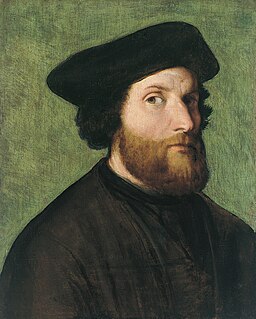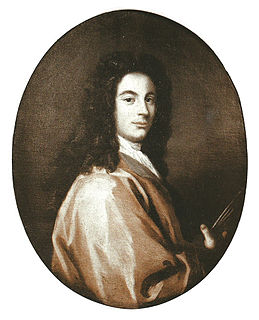
Michele di Matteo, also sometimes used with further qualifications of da Bologna or Lambertini (active 1410- 1448 or 1469) was an Italian painter of the late Gothic period in Bologna.

Michele di Matteo, also sometimes used with further qualifications of da Bologna or Lambertini (active 1410- 1448 or 1469) was an Italian painter of the late Gothic period in Bologna.
In 1410, he labored with Francesco Lola in painting processional standards for the city's reception of the Antipope Alexander V. He painted frescoes and designed windows for the Basilica San Petronio and the church of San Giacomo of Bologna.
In 1447, he painted in the church of San Giovanni at Siena the twelve articles of the Apostles Creed. He also painted a Pietà between Saints John, Mark, Roch, and Anthony Abbot (1462) and a Virgin and Child, (1469) found in the Academy of Bologna. The Gallerie dell'Accademia of Venice has an altar-piece of the Virgin and Child with Saints and scenes from the life of St Helena.
In 1428, he worked in Bologna with Giovanni da Modena. A polyptych depicting the Virgin Mary and St John the Evangelist and other Saints (1430-1437) by Michele is present at the Museum of Art of the University of Missouri in Columbia. It was painted for the church of Sant'Elena, Venice. He is also attributed a painted crucifix at the Pinacoteca Nazionale of Bologna. [1] It is not clear how this painting relates to the painting Bryan talks about at the Accademia.
The early 20th century art historians Crowe and Cavalcaselle generally dismiss the power of Michele, describing his works in the galleries of Bologna and Venice as ugly, injured and defective. [2] Some assert he differs from Michele di Matteo da Bergamo.

Lorenzo Lotto was an Italian painter, draughtsman, and illustrator, traditionally placed in the Venetian school, though much of his career was spent in other north Italian cities. He painted mainly altarpieces, religious subjects and portraits. He was active during the High Renaissance and the first half of the Mannerist period, but his work maintained a generally similar High Renaissance style throughout his career, although his nervous and eccentric posings and distortions represented a transitional stage to the Florentine and Roman Mannerists.

BartolomeoMontagna was an Italian Renaissance painter who mainly worked in Vicenza. He also produced works in Venice, Verona, and Padua. He is most famous for his many Madonnas and his works are known for their soft figures and depiction of eccentric marble architecture. He is considered to be heavily influenced by Giovanni Bellini, in whose workshop he might have worked around 1470. Benedetto Montagna, a productive engraver, was his son and pupil and active until about 1540. He was mentioned in Vasari's Lives as a student of Andrea Mantegna but this is widely contested by art historians.

Carlo Cignani was an Italian painter. His innovative style referred to as his 'new manner' introduced a reflective, intimate mood of painting and presaged the later pictures of Guido Reni and Guercino, as well as those of Simone Cantarini. This gentle manner marked a break with the more energetic style of earlier Bolognese classicism of the Bolognese School of painting.

Giovanni Battista Cima, also called Cima da Conegliano, was an Italian Renaissance painter, who mostly worked in Venice. He can be considered part of the Venetian school, though he was also influenced by Antonello da Messina, in the emphasis he gives to landscape backgrounds and the tranquil atmosphere of his works. Once formed his style did not change greatly. He mostly painted religious subjects, often on a small scale for homes rather than churches, but also a few, mostly small, mythological ones.

Giuseppe Maria Crespi, nicknamed Lo Spagnuolo, was an Italian late Baroque painter of the Bolognese School. His eclectic output includes religious paintings and portraits, but he is now most famous for his genre paintings.

Antonio Balestra was an Italian painter of the Rococo period.

Michele Taddeo di Giovanni Bono, known as Giambono was an Italian painter, whose work reflected the International Gothic style with a Venetian influence. He designed the mosaics of the Birth of the Virgin and Presentation in the Temple. His best known paintings are the Man of Sorrows and the St. Peter.
Giuseppe Badaracco (1588–1657), also called “Il Sordo”, was an Italian painter of the Baroque period, active mainly in Genoa, in Liguria and in the island of Corsica.

Giovanni Buonconsiglio was an Italian painter of the Renaissance period, active mainly in Venice and his native Vicenza. Alternate names: Bonconsigli, Giovanni; Il Marescalco; Marescalco Buonconsiglio; Il Marescalco.
The decade of the 1460s in art involved some significant events.
The decade of the 1450s in art involved many significant events, especially in sculpture.

Lorenzo di Bicci was an Italian painter of the Florentine School considered to be one of the most important painters in Florence during the second half of the 14th century. He is believed to have learned his trade from his father, about whom little is known. Lorenzo’s style, as well as that of his contemporaries Jacopo di Cione and Niccolò di Pietro Gerini, was influenced by the artist Andrea di Cione. Lorenzo's paintings made use of bright colors and his compositions avoided complexity. The figures he painted tended to have round faces and were often expressionless. Another one of Lorenzo's distinctive characteristics was his precision of execution. He was known for exceptional talent in drawing, an ability that he put to use at the initial stages of his painting. Unlike many celebrated Florentine artists of this period, Lorenzo mostly received commissions from the country clergy and from the lower-middle class Florentine guilds. His successors, Bicci di Lorenzo and Neri di Bicci, continued to serve these groups.
Matteo Balducci was an Italian painter of the Renaissance. He was born in Fontignano, a small town near Lake Trasimeno in Perugia.
Antonio Dardani (1677–1735) was an Italian painter of the Baroque period, mainly in his native Bologna..

Olivuccio Ceccarello di Ciccarello was an Italian painter. Little is known of his life. He was a native of Camerino and was active from 1388 until his death. In 2002 works formerly attributed to an obscure painter named Carlo da Camerino were re-attributed to Olivuccio di Ciccarello as it had become clear Carlo da Camerino had never existed.

Benedetto Rusconi, nicknamed the Diana, was an Italian Renaissance painter, a companion of Vittore Carpaccio and Giovanni di Niccolò Mansueti, who lived in the latter part of the 15th and early part of the 16th centuries. No date can be given of his birth.

Jacobello di Bonomo was an Italian painter, active in an early Renaissance style.

Andrea di Niccolò, also Andrea di Niccolò di Giacomo, (1440–1514) was an Italian painter of the Sienese School.
Domenico Mancini is an Italian painter of the Venetian mainland, painting in a High Renaissance style. Mancini was either a pupil or a close follower of Giorgione and Giovanni Bellini. He was born in Treviso, and is said to have worked alongside Pietro Maria Pennacchi.

The Civic Museum of Palazzo Mosca is the main civic museum of Pesaro, displaying art and decorative works, located in Piazza Mosca in this town of the region of the Marche, Italy.
| Wikimedia Commons has media related to Michele di Matteo . |